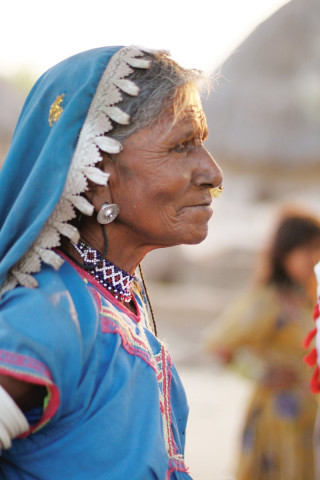Tharparkar famine: Feeding the soul
The people of Thar revel in a riot of colour despite the recent famine.


Villagers in Jageh jo Thar make their living primarily from selling firewood and leaves or plants utilised in fodder. PHOTO: TOOBA MASOOD
While Mithi and Umerkot are dotted with stalls or encampments offering relief goods, it is here in the villages that the headlines are made. On March 7, 2014, it was announced that 121 people had died due to malnutrition here since December. Amidst a flurry of official and unofficial reports, the Mithi taluka hospital said nearly 32 children had died in the month of February alone and five children had succumbed to malnutrition within the first week of March. The Tharparkar district, home to 1.5 million people, has four other talukas, including 2,000 villages spread across the largest desert region in Pakistan — the effects of drought across this area still unknown.

Sohni has lived in Jageh jo Thar, a village 10 minutes from Mithi, since she was born. PHOTO: TOOBA MASOOD
As the provincial government turned its gaze to the desert region, official death tolls swiftly plummeted and officials denied that malnourishment was leading to deaths here. “It will be wrong to say that all the deaths were caused by food deficiency and a shortage of wheat,” said Information Minister Sharjeel Memon, as official reports cited sepsis, blood infections, pneumonia, asphyxia and premature births — not food deficiency or malnutrition — as the cause of death.

The entrance to the Shiv mandir in Umerkot district. The mandir is the largest of hundreds of temples located in the district. PHOTO: TOOBA MASOOD
On the day the news broke, the National Disaster Management Authority chairman, Saeed Aleem, said that there was no confirmation of a severe famine in the area and a report by the National Drought Management Centre in January indicated that a ‘mild drought’ was being experienced in Cholistan, Tharparkar, Sukkur and Khairpur. Officials explained that drought-like conditions preceded the annual migration of Tharis to other areas of Sindh as they waited out a dry spell in September and March. Timing here is crucial as parts of the Tharparkar region did not receive monsoon rain in July and August, while other areas received sporadic rainfall. And so, while the provincial government declares the area as drought affected by mid-August every year, the announcement this year was delayed from August 2013 till February 28, 2014. While there has been no rainfall in the district since November, none was expected in the near future either. The Pakistan Meteorological Department confirmed that Thar was experiencing weather drier by 30% this year, categorising the situation as a socio-economic disaster, not a drought.

A girl’s school is under construction in the village. Girls and boys currently attend classes together, but residents of the village say they are often out of school as the three teachers employed here skip classes. PHOTO: TOOBA MASOOD
As the government focuses its energy on the provision of relief goods and medical treatment, the residents of Thar soldier on despite these challenging conditions.
On the first day of Holi, celebrations in Umerkot district kick off with young couples encircling pooja paths — offerings of agarbattis, diyas, coconuts, flowers and pictures of Lord Krishna — in the narrow lanes of their neighbourhoods, marking their first season of spring together. While the women gather in the courtyards of larger houses or on the rooftops of their homes, the men take to the streets. Hoses spray stream after stream of fuchsia coloured water, and a fine mist of glitter and coloured powder coats every surface.

Ghansham Das Waghani, who has maintained the Shiv mandir for nearly 30 years, says nearly 1,000 women had celebrated Holi at the temple over the two days. PHOTO: TOOBA MASOOD
The celebrations spill over into the next day as locals make their way to Shiv mandir, the oldest temple in a district of nearly 100 mandirs. Ghansham Das Waghani, who has maintained the mandir for 30 years claims that this year’s drought in Tharparkar has not dampened celebrations in the district’s headquarters. “Our celebrations grow by the year,” he says. “I remember when I was a boy, maybe 200 people would celebrate Holi and perform pooja in three or four spots in Umerkot. But now you’ll find celebrations in each lane.”

Locals in the Raama Peecho area of Umerkot celebrate Holi. The women stick to the mandirs or gather in the courtyards of large houses in their neighbourhoods. PHOTO: TOOBA MASOOD
He says the people of the mandir receive a lot of protocol on religious occasions and at least 40 to 50 police officials are deputed for security on such days. “You won’t be able to tell here which one is a Muslim home and which one is a Hindu home,” he boasts. In the villages, however, a small black half-moon and dot marks the foreheads of some of the little girls, distinguishing them from the Muslim girls in their villages.

Some of the girls in the villages near Mithi are distinguished from the Muslim girls by a small dot and crescent on their foreheads. PHOTO: TOOBA MASOOD
The mirth on the faces of the young and old alike temporarily erases the crisis that has befallen on these people, and you can’t help but wonder how long before they are forgotten again.
Published in The Express Tribune, Sunday Magazine, March 30th, 2014.



















COMMENTS
Comments are moderated and generally will be posted if they are on-topic and not abusive.
For more information, please see our Comments FAQ